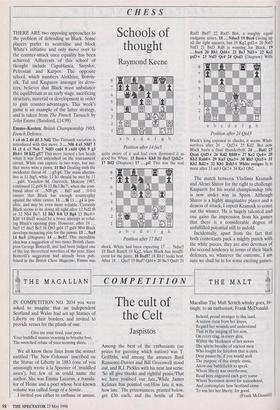CHESS
Schools of thought
Raymond Keene
THERE ARE two opposing approaches to the problem of defending as Black. Some players prefer to neutralise and block White's initiative and only move over to the counter-attack once equality has been achieved. Adherents of this school of thought include Capablanca, Smyslov, Petrosian and Karpov. The opposite school, which numbers Alekhine, Botvin- nik, Tal and Kasparov amongst its devo- tees, believes that Black must unbalance the equilibrium at an early stage, sacrificing structure, material or development in order to gain counter-advantages. This week's game is an example of the latter strategy, and is taken from The French Tarrasch by John Emms (Batsford, £14.99).
Emms-Kosten: British Championship 1985; French Defence.
1 e4 e6 2 d4 d5 3 Nd2 The Tarrasch variation is introduced with this move. 3 ...Nf6 4 e5 Nfd7 5 f4 c5 6 c3 Nc6 7 Ndf3 cxd4 8 cxd4 Qb6 9 g3 Bb4+ 10 K12 g5!? This move turned a few heads when it was first unleashed on the tournament circuit. White can capture in two ways, but nei- ther move wins a pawn. 11 Be3 Dealing with the incidental threat of ... g5-g4. The main alterna- tive is 11 fxg5, while 11 h3 should be met by 11 gxf4. Vasiukov-M. Gurevich, Moscow 1987, continued 12 gxf4 f6 13 Be3 Be7!, when the com- bined ideas of ...Nf8-g6, ...Bd7 and ... 0-0-0 ensure that Black has enough counterplay against the white centre. 11 ...f6 11 ...g4 is pos- sible, and may be even more reliable. Certainly Black seems to be doing all right after 12 Nd2 f6 or 12 Nh4 Be7. 12 Bh3 0-0 13 Bg4 13 Bxe6+ Kh8 14 Bxd5 would be a brave attempt at refut- ing Black's opening play. However, after 14 ... fxe5 15 dxe5 Bc5 16 Qb3 gxf4 17 gxf4 Nb4 Black develops menacing play for the pawns. 13 ... fxe5 14 fxe5 (Diagram) 14 ...Bc5!: This incredible idea was a suggestion of two-times British cham- pion George Botterill, and had been judged one of the top theoretical novelties of the year. Since Botterill's suggestion had already been pub- lished in the British Chess Magazine, Emms was Position after 14 fxe5 quite aware of it and had even dismissed it as good for White. 15 Bxe6+ Kh8 16 dxc5 Qxb2+ 17 Bd2 (Diagram) 17 g4! This was the real
Position after 17 Bd2
shock. White had been expecting 17 ... Ndxe5 18 Bxc8 Raxc8 19 Kg2, when Black has insuffi- cient for the piece. 18 Bxd5? 18 Rbl! looks best. After 18 ... Qxe5 19 Bxd7 Qd4+ 20 Be3 Qxdl 21
Rxdl Bxd7 22 RxdS Be6, a roughly equal endgame arises. 18 ...Ndxe5 19 Bxc6 Giving up all the light squares, but 19 Kg2 gxf3+ 20 Nxf3 Nxf3 21 Bxf3 Rd8 is winning for Black. 19 ...bxc6 20 Rbl Qd4+ 21 Be3 Nd3+ 22 Ke2 03+ 23 Nxf3 Qe4 24 Qxd3 (Diagram) With
Black's king exposed to checks, it seems White survives after 24 ...Qxf3+ 25 Kd2. But now Black hurls a final thunderbolt. 24 ...Ba6! 25 Qxa6 Qxf3 + 26 Kd2 Rfd8+ 27 Kc2 Qe4+ 28 Kb2 Rab8+ 29 Ka3 Qxe3+ 30 Rb3 Qxc5 + 31 Kb2 Rd2+ 32 Kbl Rxb3 + White resigns It is mate after 33 axb3 Qc2+ 34 Ka 1 Qb2.
The match between Vladimir Kramnik and Alexei Shirov for the right to challenge Kasparov for his world championship title is now under way in Spain. Although Shirov is a highly imaginative player and a demon of attack, I expect Kramnik to come out the winner. He is hugely talented and one gains the impression from his games that there is a considerable degree of unfulfilled potential still to unfold.
Incidentally, apart from the fact that both contestants pack a mighty punch with the white pieces, they are also devotees of the second tendency in terms of their black defences, so, whatever the outcome, I am sure we shall be in for some exciting games.


































































 Previous page
Previous page